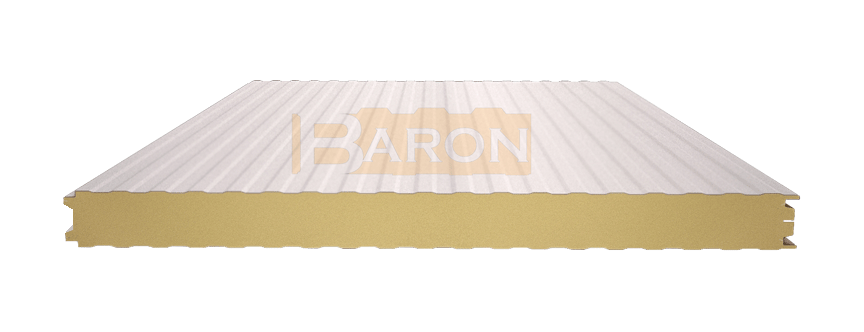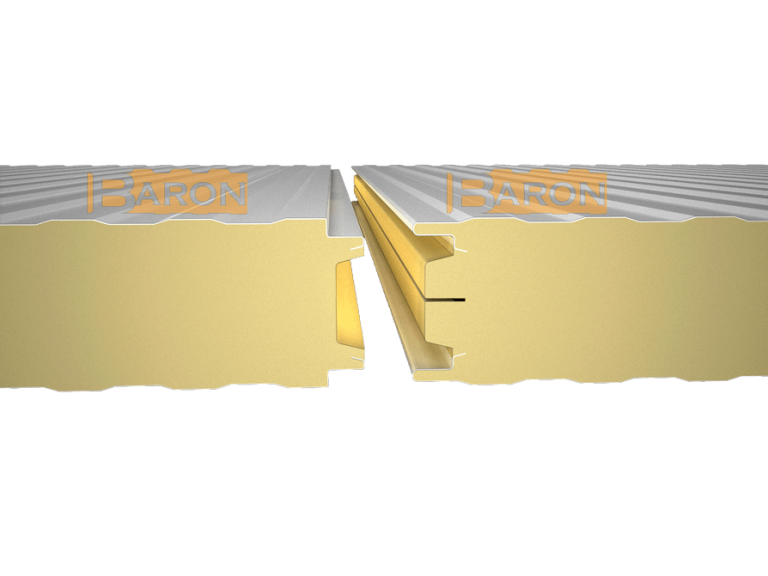
Sizes

| insulation thickness(x) (mm) | 70,80,90,100,120,150 |
| effective width (mm) | 945 , 1020 , 1185 |
| maximum length | At desired lengths and depending on shipping conditions |
Insulation layer

| density | 40±2kg/m³ |
| Heat transfer coefficient | 0/0159~0/0260 |
| foam type | PUR (B2) , PIR |
Top and bottom layers
| top and bottom sheet | Pre-painted galvanized / Pre-painted aluzinc / Pre-painted aluminum / Matte or glossy stainless steel |
| sheet thickness | 0.3 to 0.7 mm |
| forming type | Cold rolling (fine shutters, coarse shutters, smooth) |

Cape joint sandwich panel
The insulation quality of a cold store is directly related to the impermeability of the wall sandwich panels, ceiling and how the floor is insulated.
Today, in the industrial world, unlike the traditional type, sandwich panels are produced with a width of 120 cm in order to reduce the number of seams in a cold room, but the same number of seams and the distance between the sandwich panels must be well sealed to reduce energy wastage. In this case, the cooling systems of the cold store will work less and as a result, they will have a higher useful life.
Because the surface of the foam in the crotch and tab section part of traditional sandwich panels is uneven, the connection of two sandwich panels in this part is usually not airtight and causes energy waste. In traditional methods, to prevent this important event, gluing panels during installation or injection between two panels after installation, etc. were used.
In industrialized countries, cape seam panels have been used for some time to save costs and increase the speed of installation and better ventilation. In these panels, according to the thickness of the panel, one or two trapezoids are created in the form of a crotch and tab, and according to the groove that is considered in the tab part and the spring property of foam, the trapezoid surfaces in the crotch and tongue during installation with pressure They stick to each other. In this method, without the need for glue or injection, the seams are sealed in the best way, and the panels can be assembled and disassembled and moved many times without imposing excess glue and injection costs on the project.
In addition to the above, in traditional sandwich panels, paper or plastic is used to cover unevenness, voids, holes and cracks on both sides of the panel. These plastics or papers are not only contact barriers when two panels are fastened, but they can also start many fires.
The amount and speed of self-extinguishing foam is very effective and prevents fire. But because the papers and plastics covering the crotch and tab are flammable and act like fuses, they can cause accidents. To solve the above problems, a German company has recently started to produce cape seam panels and foam facade at the same time; So that the crotch and tab are completely visible without plastic or paper cover. In this way, the buyer can be sure at a glance that the foam is free of defects, holes, voids, sponginess and cracks, and the possibility of flames spreading through plastic and paper is prevented.

What is cape joint sandwich panel?
Cape joint sandwich panel has the insulation quality of a cold store directly with the impassability quality of sandwich panels of the walls, roof and how the floor is insulated.
In the industrial world, unlike the traditional type, sandwich panels are produced with a width of 120 cm in order to reduce the number of seams in a cold room, but the same number of joints and the distance between the joints of the sandwich panels must be well sealed so that less energy is wasted.
What are the characteristics of Cape joint cold storage sandwich panels?
Cape panels on the facade have foam. So that the crotch and tab are completely visible along the entire length of the panel without plastic or paper cover. When you look as a buyer you see no flaws, holes, pores, sponginess and cracks. The most important feature is that the possibility of spreading flames is prevented by plastic and paper.

Paper panel

Foam panel
Frequently Asked Tight seam refrigerator sandwich panels
What is the size of a cold storage sandwich panel?
The insulation size of this sandwich panel is 70, 80, 90, 100, 120, 150, 200, and the useful widths of the sandwich panel for cold storage are 945, 1020, 1185, and the maximum desired length depends on the transportation conditions.

